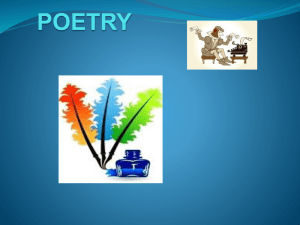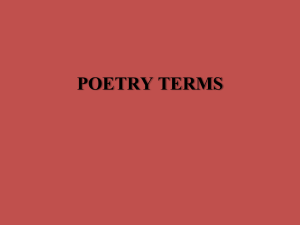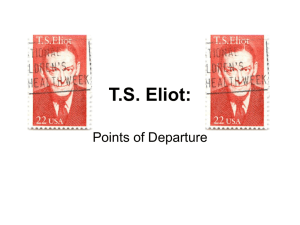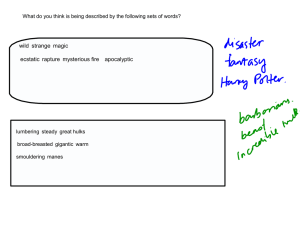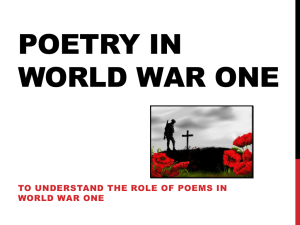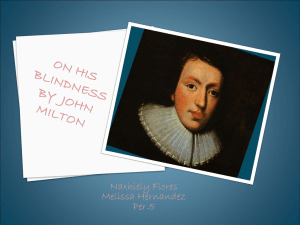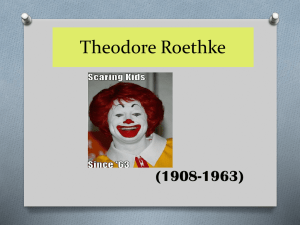Poetry
advertisement
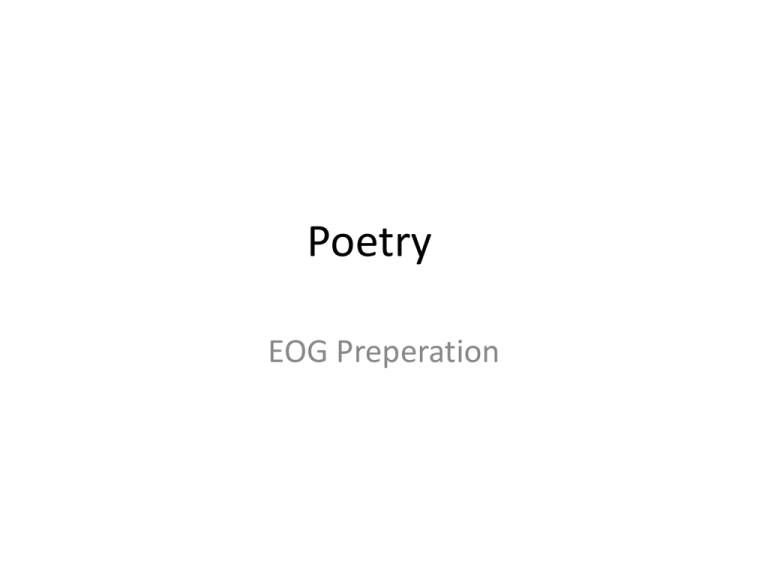
Poetry EOG Preperation Poetry Elements (1) • Songs are poems. • Poems on a printed page often have their own “music” (rhyme, rhythm, rules on number of syllables, etc.) • The first time you read through a poem, read for the main idea. Reread the poem many times. • Look for comparisons in the poem. – Figurative language: • Simile • Metaphor • Personification • Hyperbole Poetry Elements (2) • Different kinds of poetry: – Light verse – Narrative poetry – Haiku – Sonnet – Free verse – Pattern poetry – Limerick – Concrete poems Light Verse Poems • A poem that is playful and humorous • Often feature “word play” and puns • Lots of rhyming • Lots of alliteration Light Verse Poem: My Brother is a Quarterback by Jack Prelutsky My brother is a quarterback, I rarely catch a pass, and he can run a marathon, I soon run out of gas, he pitches for his baseball team, I pop up on his curve, and he’s an ace at tennis, I can’t return his serve. My brother dunks the basketball, I dribble like a mule, he swims like a torpedo, I flounder in the pool, he’s accurate at archery, I hardly ever score, he boxes and he wrestles, I wind up on the floor. My brother catches lots of fish, I haven’t any luck, he’s captain of his hockey team, I can’t control the puck, his bowling’s unbelievable, I bowl like a buffoon, he says someday I’ll start to win… I hope someday is soon. Light Verse Poem: When I Grow Up by Jack Prelutsky When I grow up I think that I may pilot rockets through the sky, grow orchards full of apple trees, or find a way to cure disease. Perhaps I’ll run for president, design a robot, or invent unique computerized machines or miniature submarines. When I grow up, I’d like to be the captain of a ship at sea, an architect, a clown or cook, the writer of a famous book. I just might be the one to teach a chimpanzee the art of speech… but what I’ll really be, I’ll bet I’ve not begun to think of yet. Narrative Poems • A poem that tells a story • They have a plot, a setting, and characters • It is always told by a narrator • Stories can be serious or humorous…it doesn’t matter as long as it tells a story • Casey at the Bat was a narrative poem Narrative Poem: The Story of Augustus Who Would Not have Any Soup? By Henrich Hoffmann Augustus was a chubby lad; Fat ruddy cheeks Augustus had: And everybody saw with joy The plump and hearty, healthy boy. He ate and drank as he was told, And never let his soup get cold. But one day, one cold winter’s day, He screamed out “Take the soup away! O take the nasty soup away! I won’t have any soup today.” Next day, now look, the picture shows How lank and lean Augustus grows! Yet, though he feels so weak and ill, The naughty fellow cries out still “Not any soup for me, I say: O take the nasty soup away! I WON’T have any soup today.” Look at him, now the fourth day’s come! He scarcely weighs a sugar-plum; He’s like a little bit of thread, And, on the fifth day, he was – dead! Haiku • Japanese form of poetry • Combines form, content, and language • 17 syllables in 3 lines with following pattern: – First line: 5 syllables – Second line: 7 syllables – Third line: 5 syllables • Usually has nature theme • A haiku doesn’t rhyme Haiku Poem The Rose The red blossom bends and drips its dew to the ground. Like a tear it falls. A Rainbow Curving up, then down. Meeting blue sky and green earth melding sun and rain. What is a Sonnet? • Content: must praise something or someone • 14 lines • Each line is an iambic pentameter (10 syllables; 5 stressed and 5 unstressed) • Rhyming pattern is abab cdcd efef gg Sonnet 18 A B A B Shall I compare thee to a summer’s day? Thou art more lovely and more temperate: Rough winds do shake the darling buds of May, And summer’s lease hath all too short a date: C D C D Sometime too hot the eye of heaven shines, And often is his gold complexion dimmed; And every fair from fair sometimes declines, By chance, or nature’s changing course, untrimmed; E F E F But thy eternal summer shall not fade, Nor lose possession of that fair thou owest, Nor shall death brag thou wander’st in his shade, When in eternal lines to time thou growest; G G So long as men can breathe, or eyes can see, So long lives this, and this gives life to thee. What is a Free Verse Poem? • • • • • Does not have rules Does not rhyme Does not have a meter It does have carefully chosen words It can be compared to a song that doesn’t rhyme • You can decide when to break your poem into stanzas (can be 2 or more lines per stanza) Free Verse Poem : Fog by Carl Sandburg The fog comes on little cat feet. It sits looking over harbor and city on silent haunches and then moves on. Pattern Poem: Cinquain • • • • • A 5-line poem following a pattern. Based loosely on the Japanese Haiku. They DO NOT have rhyming words in them. The cinquain poem is all about description. Cinquains do not have titles. However, the first line serves as the subject. What is the Structure? Line 1: Line 2: Line 3: Line 4: Line 5: A one-word line. It should be a noun. This is your subject. (1) Two adjectives about the subject. (2) Three verbs that end in –ing that are about the subject. (3) Four or five words that express your feelings about the subject or a phrase about the subject. (4-5) One word synonym about the subject. (1) Cinquain Poem Apples Hearty, healthy Growing, falling, rolling Ripening slowly on fruit trees Treats The Limerick • Rhyming, humorous, nonsensical 5-line poem • Follows a specific rhythm and pattern (aabba) • Made popular in the 1800’s by Edward Lear • Often begin with There once was… There was a… There was an old man with a beard, Who said, “It is just as I feared! – Two owls and a hen, Four larks and a wren, Have all build their nests in my beard.” by Edward Lear There was a young lady from Niger, Who smiled as she rode on a tiger; They returned from the ride With the lady inside, And the smile on the face of the tiger. Concrete Poems • Also called “Shape Poems” or “Visual Poetry” • The poem requires the arrangement of words to be as important a message as the poetry in the poem itself Poetry Elements (3) • Pay attention to sound effects. – Rhyme (repetition of sound) – Rhythm (the beat of a poem) – Alliteration (repeat initial consonant) – Assonance (repeat internal vowel) – Dialect (regionalism) Summing Up: Poetry Elements 1. The first time you read through a poem, read for the main idea. 2. Look for comparisons in the poem. 3. Read the poem again and again. 4. Understand different kinds of poetry. 5. Pay attention to sound effects. Buckle Down Activity (Put all of your answers on a separate piece of paper) • Read “Old Dog Dreaming” on page 103 (big book). Answer questions 1-8. • Read “Turning Twelve” on page 13 of Form A. Answer questions 21–25. • Read “Autumn Dreams” on page 18 of Form A. Answer questions 33-37. • When you finish a selection, come up to get answers checked. 100% gets a prize. You get ONE CHANCE to correct errors and still win a prize.


